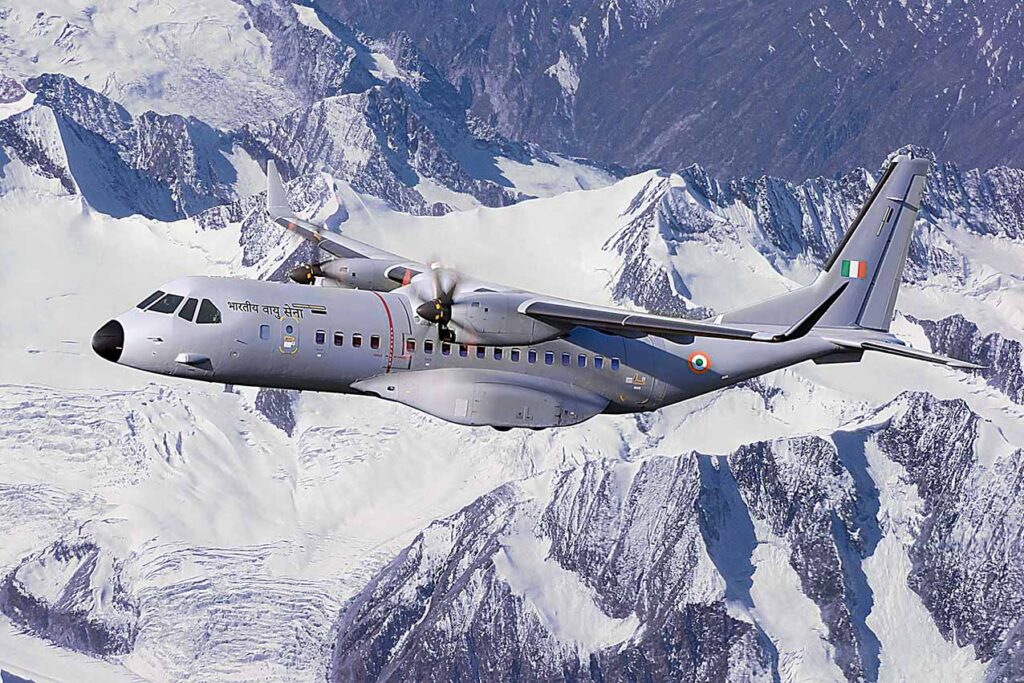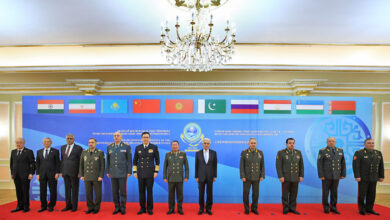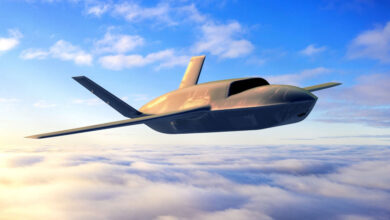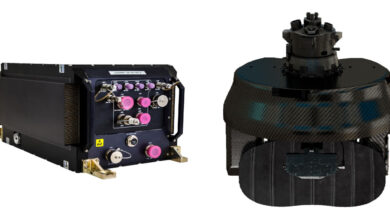Atmanirbharta in Transport Aircraft Manufacturing
By Gp Capt (Dr.) RK Narang VM (Retd)
New Delhi. Indian Prime Minister Narendra Modi laid the foundation stone of C-295 transport aircraft manufacturing facility in Vadodara, Gujarat on October 30, 2022. The C-295 deal is the second deal after the transport aircraft manufacturing deal of HS-748 Avro in 1959. It is also expected to create an ecosystem for transport aircraft manufacturing. These aircraft are likely to be employed in civil applications in due course.

India becoming ‘Atmanirbhar’ – self reliant – and a ‘developed nation in Amrit Kaal’ a- Golden Period – are the two important pillars that would act as templates for measuring the trajectory of Indian aviation manufacturing industry. Airbus Defence and Space S.A, Spain collaborated with Tata Advanced System Limited (TASL), a private sector company, to manufacture these aircraft in India under the Make in India policy. The deal worth Rs 21,935 crore involves supply of 16 aircraft in flyaway conditions while the remaining 40 aircraft would be manufactured in India.
However, there is no known plan and timeline yet for the development of its critical systems, sub-systems, payloads, etc.
Then, how would this deal fill the gaps in India’s transport aircraft manufacturing technology and capability? But the following questions should help in understanding the contribution of the C-295 deal in making India Atmanribhar in transport aircraft manufacturing :
- What was the HS-748 Avro deal and why did India have to go for C-295 manufacturing deal 63 years later?
- Does India have a roadmap and who has the ownership for building its transport aircraft manufacturing capacity?
- Why leadership, ownership & a roadmap are important for India becoming Atmanirbhar in aviation manufacturing?
HS-748: India’s First ToT for Self-Reliance
The Avro and other indigenous aviation design, development and manufacturing programs and their challenges were analysed in the book titled “India’s Quest for UAVs and Challenges”.
AVM Harjinder Singh as AOC-in-C of Maintenance Command was the architect of the HS-748 (Avro) aircraft deal. Avro was selected by beating the Lockheed CL-49 and Fokker Friendship aircraft. He withstood intense political, diplomatic and other pressures to give India its first transport aircraft manufacturing deal in 1959. He neither succumbed to pressure of British as well as the competitors of Avro, who lobbied intensely for a favourable decision.
AVM Harjinder Singh did not agree to the British offer to supply 30 Avro aircraft in flyaway condition and manufacture remaining aircraft in India. As a result, India received full transfer of technology (ToT), which has been handy in operating and maintaining HS-748 aircraft for the last 63 years.
Air Marshal Subroto Mukerjee, the Chief of Air Staff, laid the foundation stone of Aircraft Manufacturing Depot (AMD) at Kanpur on January 23, 1960 and the first IAF Avro flew its first flight on September 01, 1961. Avro aircraft was inducted by the IAF as well as by India’s national commercial airliner Indian Airlines in due course. After the retirement of AVM Harjinder Singhon August 01, 1963, the manufacturing of Avro was transferred to Transport Aircraft Division of Hindustan Aeronautics Limited (HAL) in 1964.
However, there was no roadmap for leveraging Avro deal to design and manufacture future transport aircraft in India.
Leadership and Technology Ownership for Atmanirbharta
Leadership, Technology ownership and a Roadmap are the three critical pillars for building any capability. A few Indians demonstrated supreme leadership qualities and played an important role in the Green Revolution, White Revolution, Space, Missiles, Metro, AADHAR, UPI and some other transformational programmes in India. These leaders demonstrated ownership and took difficult and challenging decisions, and risked their careers for the larger good of the nation.
Leadership
Leadership also played an important role in trajectory of aviation manufacturing after independence and this fact is documented in the biography of legendary IAF engineer and pilot AVM Harjinder Singh that was authored by his staff officer Air Cmde AL Sehgal in the book titled “The Birth of the Air Force”. Two more people who played significant role in the Avro deal and deserve mention are the then Defence Minister Mr Krishna Menon and Chief of Air Staff Air Marshal Subroto Mukerjee. Krishna Menon had urged Chiefs of three Services in Commanders conference in 1958 to give impetus to indigenous production of defence equipment while Air Mshl Mukerjee was the pillar on whose support AVM Harjinder took several technological initiatives. In fact, first Avro was named Subroto by Mr Krishan Menon to recognise the contribution of Air Marshal Mukerjee.
The leadership made all the difference and India needs visionary leaders in Ministries, departments and organisations to lead ongoing transformation and make India a transport aircraft a manufacturing hub.
The call of political leadership to make India Atmanirbhar and a developed nation has to be supported by equally visionary and courageous leadership in MoD, Ministry of Civil Aviation, defence forces and other organisations. They need to take ownership of technology, initiate organisational reforms, make roadmaps and work hard to make them a reality.
Global Aviation Technology Initiatives
The contribution of global aviation ministries/ departments like Federal Aviation Authority (FAA) of the US, Civil Aviation Administration of China (CAAC) and European Union Aviation Safety Agency (EASA) of Europe in the unmanned aviation technology development was examined in the article titled “Anushandhan led Atmanirbhar Aviation Unmanned Aerial Systems (UAS) Industry in India”. It was concluded that Aviation Ministries and departments played an important role in creating an eco-systems, building unmanned aviation design, development and manufacturing capabilities and enabling technologies in their respective countries by supporting their private aviation manufacturing industry.
China made a detailed plan to leverage collaborations to build domestic transport aircraft manufacturing capability. China signed MD-80/MD-90 transport aircraft manufacturing deal in early 1990s followed by Airbus-320, Boeing-737 and Airbus 330 manufacturing deals in 2008, 2015 and 2016 respectively. These collaborations helped China in building large civil and military transport aircraft, bombers, HALE UAVs and becoming an aviation manufacturing nation.
Will C-295 Deal Make India Atmanirbhar?
Indian Prime Minister speaking on the foundation laying stone ceremony for the C-295 manufacturing facility in 2022 highlighted that India needs 2000 aircraft in the next 15 years, which indicates enormous potential for transport aircraft manufacturing. The C-295 deal and participation of the private sector are being viewed as transformational developments. The devil lies in details and one needs to ask oneself as to how is C-295 deal different from the Avro deal? Will the C-295 deal make India Atmanirbhar in transport aircraft design and manufacturing!
India bagging Avro aircraft manufacturing deal in 1959 was an impressive achievement for a country that had come into existence barely a decade ago (in 1947). The major difference between the Avro and the C-295 program is that the first one was steered by the government entities, I.e. IAF and HAL while the latter is steered by the private sector entity TASL. AVM Harjinder Singh and Air Marshal Mukerjee had demonstrated leadership by acquiring the Avro aircraft technology for India. Did the successors take the ownership of Avro program to modify, upgrade and develop more transport aircraft? Was there an effort to leverage Avro program to make a roadmap for building systems, sub-systems, components and design future transport aircraft in India?
Why did India have to go for C-295 transport aircraft manufacture deal in 2022 after taking ToT of Avro six decades ago. Did India have plans to leverage Avro deal for building commercial aviation manufacturing capability or does it have a plan to become transport aircraft manufacturing nation?
It is apparent that the HS-748 Avro deal was not leveraged for building transport aircraft manufacturing capability in India. However, the moot question is whether C-295 deal in the private sector would change the transport aircraft manufacturing trajectory of the country? We need to have a good leadership, ownership and a roadmap for design, development, manufacturing and export of transport aircraft in India.
Trajectory for Atmanirbharta
License manufacturing and Atmanirbharta comprising indigenous design and manufacturing are different capabilities. License manufacturing is a low value capability in which there is always dependence on the Original Equipment Manufacturer (OEM) and it does not make one Atmanirbhar as we have seen in license manufacturing of MiG-21, Jaguar, Su-30 and many other programs. On the other hand, road to atmanirbharta by leveraging license manufacturing involves building indigenous design and manufacturing capability. Atmanirbharta heavily depends upon the leadership, ownership, a roadmap and focused technology initiative to fill technology and capability gaps. Atmanirbharta creates high value industry with high paying jobs, bigger manufacturing ecosystem, greater financial gains and export potential. To stimulate civil aircraft manufacturing, a few initiatives that could make India atmanirbhar.
- Ministry of Civil Aviation (MoCA) establish R&D Directorate, take ownership and launch aviation technology development initiatives.
- Ministry of Defence (MoD) and MoCA work with industry to lay down modalities and timeline for leveraging C-295 aircraft deal to design, develop, manufacture systems, aero-engines, hydraulic, engine pumps, undercarriage, sensors, other systems, materials and software in India.
- Define ownership, funding and timelines for the development of future variants of C-295, RTA-70/90 and Saras Mk-2.
- Make a roadmap with timelines, funding and ownership for designing and manufacturing future transport aircraft to make it Atmanirbhar in Amrit Kaal.
Prime Minister Modi has urged Indian citizens to make India Atmanirbhar and a developed nation by the 100 years of independence, in 2047.
This requires actions and initiatives by Ministries, bureaucracy, organisation and institutions associated with the aviation sector.
(The author is a former senior fellow at CAPS)





